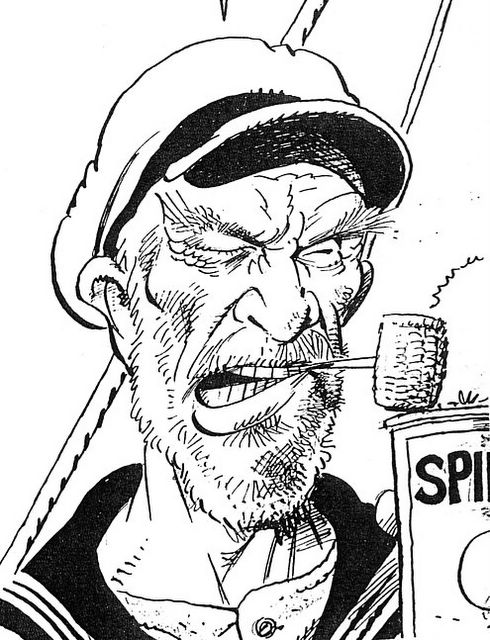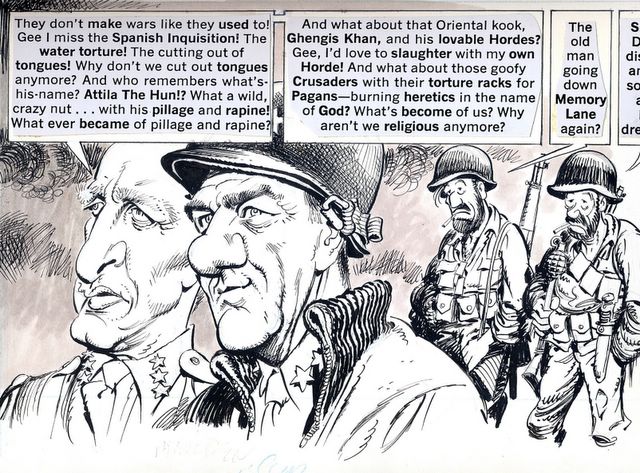The current issue spotlights Mort Drucker (born 1929), the movie satirist who worked for Mad Magazine for more than 50 years.
 |
| Correction: Ray Walston as Poopdeck Pappy |
The article includes about 50 large images of Drucker's work, mostly reproduced from the original, so that you can see the pasted-up text as if it is on the page in front of you.
The article is written by David Apatoff, author of the popular blog Illustration Art. David is a close friend of Drucker and was with him recently at the Society of Illustrators in New York, where Drucker received a coveted Hall of Fame award.
He continues: "I wanted to be as good as I could possibly be. No shortcuts. If you had a problem with something, attack it. Like hands, for instance.... Some artists drew hands in pockets or behind their backs and you knew those artists didn't want to have any part of drawing hands. But I always thought that if something's difficult, don't hide, don't run away from it. Learn to master it. That was my philosophy. And so I'd draw hands as if my life depended on it. If you can't draw hands don't look at how somebody else draws hands, study your own hand, do things so that you personally get to know and appreciate hands."
-----
You can get this issue of Illustrator's Quarterly at Bud's Art Books.
Books on Drucker: MAD's Greatest Artists: Mort Drucker: Five Decades of His Finest Works
Familiar Faces: The Art of Mort Drucker
David Apatoff is also the author if the recent book The Life and Art of Bernie Fuchs











10 comments:
As they say the only real way to learn in the end is to draw from life and to do it a lot. That being said, and this ties into your podcast tape from the other day, I think it takes a lot of self discipline to carry out the amount of work it takes to truly improve and to keep your ego out of it in the meantime. As someone who has been learning to draw through books and is still probably in a relative beginner stage those are things I definitely struggle with. Sometimes when attacking a subject with trial and error I feel I am going in circles or even backwards which can quickly lead to frustration. I imagine that gets better with experience though. -Jon
That's actually Ray Walston as Poopdeck Pappy.
Paul, it sure does look like Walston.
Hah! Mort Drucker is an artist after my own heart. I go after challenging material because why not? Why wouldn't you want to do that? It's been proven that you only learn by pushing your boundaries—albeit usually to the extent that you're just over your comfort zone and can still tell where you're going wrong. But push your boundaries you must to learn, and especially to learn quickly.
My tutor tells me I don't have much of an ego. Which is very true. My tutor's teaching methods would drum out any artist with a large ego and whose ego was so fragile that they couldn't stand being challenged to experiment and sometimes royally screw up. I'm very self-driven with my own learning, which my tutor tells me is actually needed to go beyond art school; if you only stick to art school assignments, you won't get very far. (I don't go to an art school, I can't afford it.)
And I love my tutor because I'll go to them with something as challenging as "hey, I want to use duotone palettes, in particular phthalo blue (red shade) and yellow ochre, for a while" and be met with "then paint without ever putting pure phthalo blue on the page. Not for skies, not for water, not for shadows, not for irises." I'll want to challenge myself with using a rainbow-style color theme for portraits, and my tutor will say, "Do so, and then tell me why your rainbow color theme evokes the subject's actual skin tones."
That stuff, I eat up. If I don't challenge myself in drawing or painting a thing, I will add something challenging. And I work in the most unforgiving conditions possible—ink and also watercolors where I neither lift nor scumble—because mistakes are inevitable, and I might as well learn how to deal with them, and that's always been better to do than worrying about errors, which I do notice and learn from, but I don't let them stop me.
But... students far more experienced than me grumble and yell and whine and quit. And they don't even have teachers or tutors as rough as mine. It took me a while to realize that this sort of drive not only isn't the drive of every artist, but it actively annoys them to see someone like me.
Life is strange.
Thanks so much for telling your readers about Mort's article, James. He is revered by his fellow artists, who gave him a standing ovation at the Society of Illustrators Hall of Fame dinner, and Steven Spielberg and George Lucas are huge fans who collect his work, but I still think that when it comes to the general public Mort is one of the most under recognized talents around. I hope that the high rez images in this magazine will show readers what he can do.
You are absolutely right, Mort is completely self-taught, although he is quick to say he learned a lot looking over the shoulders of Alex Toth and Joe Kubert when Mort was an apprentice. One thing I didn't mention in the article was that Mort was originally left handed and his parents forced him to switch to his right hand when he was a boy. You have to wonder how his work would have been affected if he was allowed to continue drawing left handed!
Once again, thank you for the kind review.
Drucker often doesn't get the recognition he deserves, particularly compared to caricaturists like Al Hirschfeld and David Levine. Mostly, it's because his primary venues were the hight of low culture: MAD Magazine and TV Guide. But, as you point out, Drucker didn't just create a single drawing of his characters, in his MAD parodies, he created panel after panel — in action poses, in storytelling sequence and from multiple angles and perspectives — and amid dozens of other dead-on and hilarious caricatures!
Drucker is the only one of the post-EC MAD artists that I put on par with Wally Wood, Will Elder and Jack Davis (which, for me, is saying a lot.)
Not shortcuts is probably an understatement in Drucker's case, but I think enthusiasm for what he was doing carried him quite a ways. He did it all with a drawing style that had more life, spring and out and out fun in every line than any other cartoonist or comic artist I can think of.
As for his study of hands, he mastered them so well, they are a joy in themselves. As David Apatoff mentioned some time ago, you could devote extensive study just to the way Drucker draws hands!
Simply amazing.
Used to love my subscription to Mad Magazine. There was something amazing to me about how you captured the very essence of someone's face or form with such an economy of strokes. And whether the humor was the height of low culture or the culture was predominately of a low nature and Mr. Drucker was acting as a type of historian, it was enough to get me to subscribe. I think I read somewhere that the creation and recognition of puns and parody and satire are markers for intelligence and the higher functions of the brain, and if so, then Mad Magazine exposed a lot of genius!
I love seeing Drucker get the recognition that he deserves. His ability to distill the essence of a personality and put it on paper is second to none, and never with pointless or tasteless exaggeration. So many of those guys were brilliant, and I used to pore over the drawings. About Mad in general, I feel so lucky that I discovered it as kid. The idea that everything can be, and should be, looked at satirically was a major awakening for me.
I keep on wondering if these hands were drawn "offhand".
Or should there have been some kind of model for each one of these great renderings?
I love how he has Bill Mauldin's Willy and Joe in the background in the panel from Patton. That was a nice nod to someone I bet was an inspiration to him.
Post a Comment